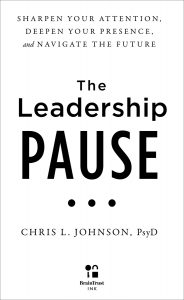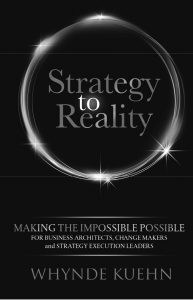Leaders need quiet time to recharge and to discern what moves are needed next to keep the organization moving forward and not sideways or reverse. In addition, they need to have a good execution plan to be effective and make the leadership role easier. Each book reviewed this month addresses one of those two important factors needed for a leader to be and remain successful.
THE LEADERSHIP PAUSE
Chris L. Johnson, Greenleaf Book Group, 2022, 320 pages, hardcover, $28.
The business of facilities is not easy. There are pressures from trustees, executives, bosses, customers, and stakeholders, many of whom we don’t know and don’t even realize are paying attention. This is particularly true for higher education facilities, because higher education has been under a microscope for high costs. As facility officers at all levels realize—from shop to service department up to the top—leading these different areas of responsibility requires focus on details, management of tight budgets, and responsiveness. It’s all high pressure; the pressure can be hard on anyone. If you don’t have a “relief valve,” then you need to find one.
 The Leadership Pause will help provide answers for a person facing a lot of stress and difficult decisions. There’s general recognition that everyone needs a pause of some kind. There are breaks in the day, such as a break to have a meal, or before the start of a workday. These are short breaks, and some use them to socialize with coworkers, but some focus on quiet time to read a book or magazine. Virtually all businesses offer time off and a vacation, and employees can take a vacation for the full time (frequently two weeks) or in smaller pieces. Some businesses provide for additional “mental health” time. However, all this time can be wasted if it isn’t used effectively; The Leadership Pause offers tools to use this break time wisely or to create additional break time.
The Leadership Pause will help provide answers for a person facing a lot of stress and difficult decisions. There’s general recognition that everyone needs a pause of some kind. There are breaks in the day, such as a break to have a meal, or before the start of a workday. These are short breaks, and some use them to socialize with coworkers, but some focus on quiet time to read a book or magazine. Virtually all businesses offer time off and a vacation, and employees can take a vacation for the full time (frequently two weeks) or in smaller pieces. Some businesses provide for additional “mental health” time. However, all this time can be wasted if it isn’t used effectively; The Leadership Pause offers tools to use this break time wisely or to create additional break time.
A concept highlighted throughout much of the book is SCOPE: Space, Connection, Openness, Pace, and Energy. These five elements frequently appear in tabular form at the end of a chapter, and are used to outline different examples of creating a pause and focusing the mind on what is important during a break in the workday. The SCOPE elements focus specifically on the chapter’s contents and how each element applies. It’s a good way to organize things. An exercise for individuals interested in utilizing the techniques presented in Leadership Pause would be to construct a table for each chapter and to write down how SCOPE is described there.
There is a significant list of other references, including several mentioned in the text; there are also many footnotes in each chapter. Overall, The Leadership Pause is a well-written book that will help individuals looking for guidance in managing the stress of their jobs. I know from personal experience that taking a pause during the workday or week is extremely helpful and provides an opportunity for a leader to identify what’s important, protect their focus on tactical and operational plans, and delegate work appropriately. Following the advice found in The Leadership Pause will make the job of being a leader more fruitful and tolerable.
STRATEGY TO REALITY: MAKING THE IMPOSSIBLE POSSIBLE FOR BUSINESS ARCHITECTS, CHANGE MAKERS AND STRATEGY EXECUTION LEADERS
Whynde Kuehn, Morgan James Publishing, 2023, 186 pages, softcover, $18.95; eBook, $9.99. Hardcover not available at this time.
The success of an organization is achieved through good employees, a clear mission, and good leadership. However, bringing these three things together may not be enough. That’s the focus in Strategy to Reality, which argues that success comes from designing the appropriate business structure for the team, for the customers, for potential events, and for the organization’s goals. The design effort and outcomes are called Business Architecture and the person who does this is called a business architect.
 Designing an appropriate and successful business architecture helps the organization improve its work processes and respond to different events that may arise. I liken it to thinking about how the facilities organization will receive work, distribute it, and gather information about actions taken in order to analyze what has happened in the past and to better predict what will be required in the future. A well-designed business architecture also responds favorably to different emergencies or perturbations in the system (workday/week) and helps to keep the organization running smoothly.
Designing an appropriate and successful business architecture helps the organization improve its work processes and respond to different events that may arise. I liken it to thinking about how the facilities organization will receive work, distribute it, and gather information about actions taken in order to analyze what has happened in the past and to better predict what will be required in the future. A well-designed business architecture also responds favorably to different emergencies or perturbations in the system (workday/week) and helps to keep the organization running smoothly.
In Strategy to Reality, Kuehn presents the rationale for developing personnel who can design the business architecture or engage a consultant to do so. For those who wish to develop the business architecture with internal forces, the development process is described with several examples, including the steps necessary to get started and to reach a completed design. As with many designs, there is never a finished product, just a circular process of planning, executing, analyzing, and revising to make the architecture better and more resilient.
As we saw during the pandemic, many facility organizations had to respond frequently to changing information, recommendations, and requirements to keep facilities operational and safe. Those organizations that were able to respond quickly and successfully had a good business architecture or were able to develop one in a short amount of time.
If you feel there are opportunities to make your organization more robust and improve the value of the services you deliver, implementing the recommendations in Strategy to Reality will prove to be a wise investment. It helps identify the type of person who can design a business architecture as well as the steps needed to be thorough and thoughtful in going about it.
Ted Weidner is an associate professor at Purdue University and consults on facilities management issues primarily for educational organizations. He can be reached at [email protected]. If you would like to write a book review, please contact Ted directly.
Bookshelf
Book reviews on current publications relevant to the profession, trends, and working environment of facilities and educational managers and professionals. To contribute a book review, contact Ted Weidner, field editor of this column.
See all Bookshelves.


